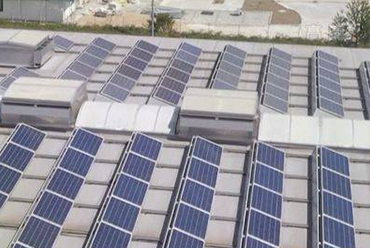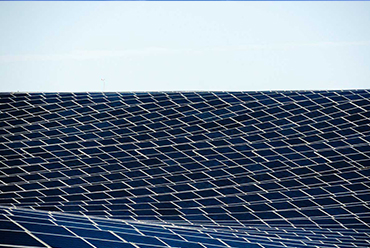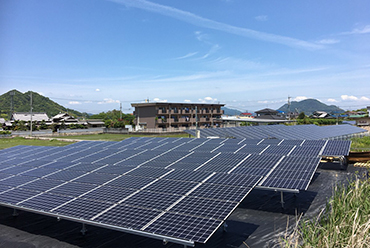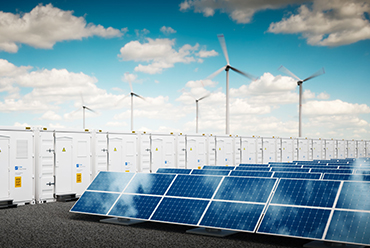
Ukraine's solar industry is stagnating because of the war. This has led to the loss of more than 1GW of capacity and halted most PV development in some areas. Despite the current war, some trade bodies have called for Ukraine's subsequent economic recovery to be led by renewable energy, with a target of 50 per cent of electricity generation from renewables by 2030. Artem Semenyshyn, CEO of the Ukrainian Solar Energy Association (ASEU), said: "As a recovery measure, we aim to build one million solar roofs across Ukraine. At the same time, Europe's gas supply crisis has morphed into a broader energy crisis, triggering price uncertainty and pushing market volatility to August 2022 heights. In Germany and France, the one-year power purchase agreement price exceeded 1,000 euros per MWh ($987 per MWh) for the first time, while in the Netherlands, the power purchase agreement price exceeded 300 euros per MWh. And recently , more and more inquirys and orders for solar roof mounting( including tile roof hooks, rails, clamps , steel rooof hooks ect) also show the increase of the solar roof projects. The below products from UISOLAR win a nice market. UI-IK-01 UI-IK-02 UI-IK-08 UI-IK-09 UI-IK-11 UI-IK-30 UI-IK-31 UI-IK-32 UI-IK-33 UI-IK-34
Read More
High temperatures and severe drought in Europe this summer have affected hydro, nuclear and solar power generation. Statistics from the Norwegian consulting firm Rystad Energy show that in the first seven months of this year, Europe's hydropower generation decreased by 20% compared with the same period last year, and nuclear power generation decreased by 12%. High temperatures lead to increased evaporation in rivers, lakes and reservoirs, lowering water levels, and hydropower bearing the brunt. In Italy, for example, hydropower accounts for 20% of the country's total electricity production, but the country's hydropower production has plummeted by 40% in the past 12 months. Hydropower production in Spain also plunged by 44%. Energy analyst Fabien Langningen said that although hydropower production fluctuates widely, the 40% drop is "very extreme", not only in local areas, but all European hydropower majors have not been spared. Energy exporter Norway has warned that it may have to stop exporting energy to countries such as the UK if the country's reservoirs fail to recover. Insufficient investment in hydropower infrastructure and aging transmission lines are also reasons for the decline in hydropower production, some hydropower industry experts say. Eddie Ritchie, an expert at the International Hydropower Association, said: "We are going to have (power) problems this winter. This should be a wake-up call for us to invest more in infrastructure in the next few years." The drought has also affected nuclear power, with France being particularly affected. Several nuclear power plants of EDF have cut production in recent days, because the water temperature in natural waters is currently high, affecting the water used for cooling reactors in nuclear power plants. Sonia Senaviratner, a professor at ETH Zurich, explained that if the water level in the river is too low and the water temperature is too high, the cooling of the reactor can only be stopped, otherwise the discharged water will endanger the life in the river. The French government on the 5th of this month instructed a crisis response working group to coordinate the work of various departments to deal with the drought. "This is the worst drought ever recorded in France," the French prime minister's office said in a statement. High temperature weather is also not conducive to solar power generation, because photovoltaic power generation panels are "afraid of the sun", and high temperature will lead to power loss of power generation panels and shortened service life. Kathryn Porter, a consultant at energy consultancy Watt-Logic, said that when temperatures exceed 25 degrees Celsius, the output of photovoltaic panels drops significantly, and "everything works worse when the temperature is high".
Read More
The National Renewable Energy Laboratory is exploring different paths to 100% emissions-free electricity in the United States. From pv magazine USA There are many paths to reach 100% emissions-free electricity. The US Department of Energy’s National Renewable Energy Laboratory (NREL) has released “Examining Supply-Side Options to Achieve 100% Clean Electricity by 2035,” which looks at multiple scenarios. NREL concludes that a 90% clean grid will have a low incremental cost, and that it can be built primarily with new wind, solar, storage, and transmission. However, the last 10% will present financial challenges, requiring research and new technologies. The lab points to four “critical hurdles” to reach 100%: 1.Dramatic acceleration of electrification and increased efficiency in demand 2.New energy infrastructure installed rapidly throughout the country 3.Expanded clean energy manufacturing and supply chains 4.Continued research, development, demonstration, and deployment support to bring emerging technologies to the market (the last 10% challenge) Across all of their main scenarios, the lowest cost electricity mix is dominated by wind and solar, which provide most of the generation (60% to 80%). By the end of this decade, solar will require additions of 40 GWac to 90 GWac per year, and wind will require additions of 70 GW to 150 GW per year. By 2035, the United States will need to have added 2 TW of wind and solar combined. Other accomplishments that must also happen by 2035 include the deployment of 5 GW to 8 GW of new hydropower, 3 GW to 5 GW of geothermal, and 120 GW to 350 GW of diurnal storage. Hitting these targets will require $330 billion to $740 billion in overall capital. Another complex issue is that the models require between 1,400 and 10,100 miles of new high-capacity lines each year. NREL says this will triple the deployment volume rate being installed today. Solar in the United States will need to massively increase deployment, with installation rates two to eight times that of the 15 GW of capacity that was added in 2020. These future annual installation volumes will be 25% to 110% of the entire capacity installed throughout the world in 2020.
Read More
The listed subsidiary of PV project developer Solar Philippines plans to build an additional 3.5GW solar plant on the basis of a 500MW system under construction on the northern island of Luzon in the Philippines. Solar Philippines claims this will make it the largest PV project in the world. The cumulative capacity of the planned project is 4GW, which will surpass the current largest solar project in the world, the Bhadla solar power plant in Rajasthan, India, which has a capacity of more than 2,245MW. UISOLAR is also experienced in designing solar power plants. We have completed many projects around the world Since 2016, Solar Philippines has been able to plan a project of this scale through efforts to acquire land and permits. This batch of projects will help the company to take advantage of the basic transmission facilities built for the initial 500MW plant. The solar power station will stretch for 60 kilometers and reach Metro Manila, one of the world's largest metropolises.
Read More
Wood Mackenzie, a U.K.-based data provider,released its Global Energy Storage Outlook recently. According to the report, global cumulative energy storage deployments are expected to reach 500 GW by 2031 with the United States and China representing 75% of worldwide demand. Wood Mackenzie said it sees the U.S. becoming a 27 GW per year market by 2031, and 83 percent of that figure will be utility-scale storage. The EU energy storage sector is set to grow as a result of the European Commission's REPowerEU initiative, which drives a greater share of renewable energy supply in EU member states. Especially Germany's energy storage business is expanding and is expected to surpass the U.S. and China to become the third largest energy storage market by 2030. China released a five-year plan for energy storage this year that calls for a large-scale development supply chain by 2025, in which the country aims to reduce system costs by 30 percent through improved technology performance. UISOLAR is also committed to making a cleaner world by providing solar mounting structures all over the world. We have developed many different solar mounting solutions for specific project conditions. The general categories are solar ground mounting, solar roof mounting, solar carport mounting, etc. Customized is acceptable, even under severe conditions, and we hope to contribute to environmental protection by spreading our products around the world.
Read More
According to Solarzoom, With European battery capacity expected to reach 124GWh by 2022, major Asian battery producers will expand their presence in the region and invest in many new European giga factories. The Fraunhofer ISI Institute predicts that battery production will quadruple in the next three years to more than 500GWh; by 2030, it will reach 1.5TWh. The latest figures show that Europe is likely to accommodate about a quarter of the world's battery capacity by the end of the century, with battery factories currently announced to cover at least 15 European countries. Fraunhofer ISI forecasts that by the end of the decade, new battery production plants in Germany will contribute the highest share of Europe's 400GWh battery capacity. Battery-electric drives have become a focus of the global automotive industry as they help reduce massive greenhouse gas emissions. Sustainable power storage solutions are also battery based. The growing demand for batteries requires the rapid construction of manufacturing plants that can meet the needs of different industries. Fraunhofer ISI researcher Lukas Weymann said: "The rapid development of battery production in Europe is mainly driven by European companies such as Northvolt, Volkswagen (VW) and the Automotive Cells Company (ACC). ." Northvolt is actively implementing an expansion strategy across Europe. Northvolt is targeting a maximum battery capacity of 40GWh when the company's five factories are completed. Overall, more than 40 battery makers, including non-European battery makers such as China's CATL and Tesla, have announced plans to build battery plants in Europe. These manufacturers all plan to build factories in Germany. With their Eastern European plants, South Korean battery producers LG Energy Solution and Samsung SDI will also have a very high share of European battery capacity. ACC has announced the construction of gigafactories in Germany, France and Italy. ACC will gradually build battery factories in these three countries. ACC benefits from the support provided by the European Union's Important Project of Common European Interest (IPCEI). Automakers Mercedes-Benz, Stellantis and French battery maker Saft are all shareholders in ACC, and they will also share investment in the construction of the battery plant. India has also witnessed a sharp rise in battery demand as sales of electric vehicles increase. According to a joint report by NITI Aayog and Rocky Mountain Institute, India's annual battery market could exceed $15 billion (approximately INR 1.12 trillion) by 2030, and battery demand will was pushed up to 260GWh.
Read More online service
online service +86 (0592)5663849
+86 (0592)5663849 sales@uisolar.com
sales@uisolar.com solar-mount.au
solar-mount.au